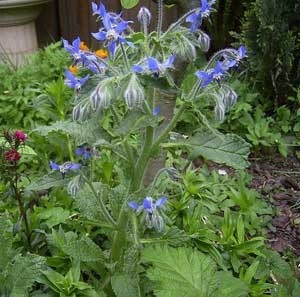
| Botanical Name: |
| Borago officinalis |
| Common names: |
| Borage |
| Description: |
| Borage is loved by bees and gardeners alike for its bright blue, star-like flowers with prominent black anthers and light-catching, silvery-haired foliage. Plants may have white or pink flowers on occasion. |
| Life Cycle: |
| hardy annual |
| Exposure: |
| full sun or partial shade |
| Cultivation: |
| Borage will do well in any type of garden soil, but its long taproots keeps it from transplanting well or growing well in containers. Plants are annuals, but readily self-seed once they become established. Advertisement |
| Propagation: |
| seeds, self-sowing |
| Parts Used: |
| flowers and leaves; the entire herb has a cucumber-like fragrance |
| Harvesting and Storage: |
| Gather leaves and flowers when plants are just beginning to flower. Collect them early in the afternoon when the sun has dried the morning dew. Discard any leaves and flowers that are torn or damaged. |
| Medicinal Uses: |
| (leaves and flowers) used as a diuretic, relaxant, inhalant for chest colds and works to aid in milk production for breast-feeding. Borage is also rich in nutrients like calcium and potassium. |
| Culinary Uses: |
| (leaves and flowers) soups, garnishes; fruit punch, cocktails, |
| Other Uses: |
| skin lotion |
| Notes: |
| Because of the presence of nitrate and potash, Borage will emit tiny sparks with a slight explosive sound when burned. |
Check out these photos.
Borage has recently become my absolute favorite herb blossom! It is extremely short-lived, with flowers usually not lasting much longer than 24 hours.